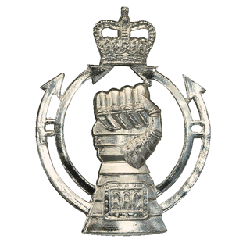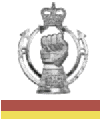|
British Army: 2300AD
The main land based striking power of the British Army lies with the various regiments of the Royal Armoured Corps. These units man both heavy and hover tanks as well as armoured reconnaissance forces. Several British armoured units have seen combat against the Kafers, and that number is expected to rise if the fighting continues. The RAC is composed of four main forces. Firstly the old cavalry regiments of the British Army that have discarded their horses centuries ago but have maintained the traditions that make them unique. The Royal Tank Regiments, the new Royal German Legion armoured regiments and lastly the Yeomanry Regiments of the TA. However this document is only concerned with the first three. Like the infantry the Royal Armoured Corps regiments have great regimental spirit. However it should be noted that most of the regiments are individual entities in their own rights. Thus whilst the 1st and 2nd Dragoons share the Dragoons title that is all they have in common, they have entirely separate uniforms and traditions etc. The exceptions to this rule are the Life Guards, Light Dragoons, Royal Tanks and RGL regiments, which have a shared regimental culture. Regiments The Household Cavalry The Household Cavalry consists of two regiments descended from the King's bodyguard and one from Cromwell's cavalry of the English Civil War. They continue to provide immaculate mounted horsemen for ceremonial duties (the Household Cavalry Mounted Regiment) as well as three regiments equipped with the latest hover tanks. The officer corps of the Household cavalry, much like that of the Guards Division, is very socially exclusive having attended all the right schools and universities and having family links with the aristocracy and sometimes even the Royal family itself. The Household cavalry nevertheless maintains an excellent reputation for its work on the battlefield. The Household regiments are all deployed with the 1st Armoured Division based in Aldershot, where its officers remain in close contact with London society. Currently two officers of the 1st Life Guards are also Members of Parliament, and five Household Cavalry officers sit in the House of Lords.
The Cavalry The rest of the cavalry has undergone a huge expansion through the last century, as Britain's defence commitments have grown. Also as the manpower required to staff a regiment has fallen, more regiments have been created. As a result the cavalry regiments have de-amalgamated to a remarkable degree, recreating regiments last seen in the 19th Century. Most of these have re-developed separate cultures, only the Light Dragoons have retained a common culture with frequent cross-postings. Whilst a career in the military is often looked down on in polite society, the exception for the upper middle classes is the cavalry. Cavalry dress uniforms have returned to their gaudy heights of the horsed era, and can often be seen at the best society balls. The cavalry despite its peacock tendency still has great reserves of skill and professionalism and is armed with some of the most advanced weaponry available. It has also been at the forefront of tactical innovation in the deployment of combined arms ACV battle groups. Dragoons and Dragoon Guards are traditionally heavy cavalry and today normally operate with hover tanks in the Medium Tank role. Light Dragoons, Hussars and Lancers are light cavalry and are more often assigned to the armoured reconnaissance role. There are three separate numbering sequences within the cavalry. That for Dragoon Guards (converted centuries ago from Horse regiments), Dragoons, and Light Dragoons. The later includes Hussars and Lancers which were converted from Light Dragoons in the 19th Century, as well as the current Light Dragoons which were converted back from Hussars in the 21st Century.
The Royal Tank Regiment The Royal Tank Regiment was created to man the original tanks used in the 1st World War, and today is used to man both heavy and medium tank units. Socially the RTR is a million miles away from the pomp and social glitter of the cavalry regiments. Soldiers in the Royal Tanks see themselves as the professionals of the Armoured Corps and are often hugely scornful of the cavalry. On occasion this has led to physical violence in pubs and clubs between the different units.
The newly formed mercenary RGL was created to provide a convincing OPFOR for realistic manoeuvre warfare training. It rapidly proved so successful that it was decided to expand the force to brigade size. As a result dedicated armoured units were raised. The Dragoons in the Medium Tank role and the Hussars as Armoured Recce. Despite their traditional titles the highly professional RGL units have more in common with the RTR than the other cavalry regiments.
Armoured Regiment Roles The regular armoured regiments of the British Army have three main roles, but share the same internal organisation. A regiment consists of four 'sabre' squadrons lettered from A to D, consisting of 12 tanks per squadron, and a HQ Squadron. The HQ Squadron has a signals and administration platoon to support the regiment's two Tactical or 'Tac' HQ's from which the Commander and 2nd in Command (2 i/c) command the regiment. The HQ Squadron also has a Recce Troop and a Drone Section to provide information and a Defence Troop for protection. A REME unit is attached to each squadron for maintenance and repair of the equipment. Manpower in an armoured regiment is normally between 250 and 300. Heavy Tank Regiments Heavy tank units are equipped with tracked heavy tanks and are designed for heavy combat, probably in Europe. HT units lack mobility though and require lighter support if they are not to be out flanked. However for assault and defence missions they are ideal. They are currently equipped with Churchill ground tanks. Medium Tank Regiments MT units are equipped with hover tanks and form the back bone of British armoured formations. Armed with impressive firepower and blessed with excellent mobility MT units can take on most tasks, and when combined with infantry in battle groups they can take on almost any opponents. MT units will normally avoid combat with opposing tank units and attempt to penetrate though gaps in his lines and caused havoc in his rear areas. Montgomery and some later model Cavalier Hovertanks equip these units. Armoured Reconnaissance Regiments Recce units are equipped with light ACV fighting vehicles equipped with drones and extensive sensor arrays. Recce units are normally employed at Divisional level to provide tactical information for the division to plan its operations. However some are deployed at Corps level and provide operational intelligence. The recce role is a demanding one requiring an additional Troop (3 hover tanks) to be attached to each Squadron to provide fire support to the recce vehicles. When in operation a recce unit may be spread over hundreds of miles with each of its squadrons operating independently of one another and far in front of friendly troops. Troopers may also spend much of their time on foot manning observation posts (OP's). Although the recce regiment's raison d'Ítre is to provide information, they may also carry out raids on lightly protected logistics and rear area troops. Armoured recce units are now all equipped with the Craufurd recce ACV, support troops are equipped with a mixture of Montgomery or Cavalier HBT's. Copyright 2009, D Hebditch |


